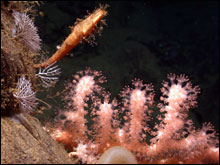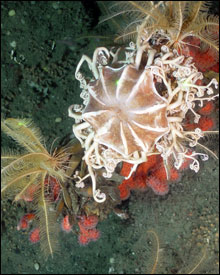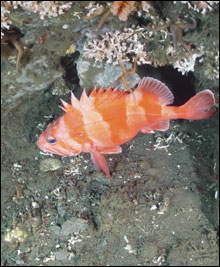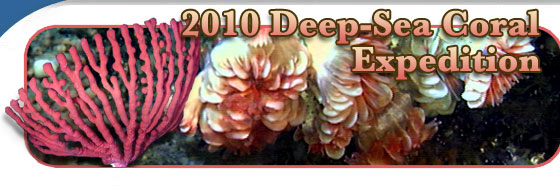Error processing SSI file
|
About Deep Sea Corals
Jeff Hyland
Supervisory Ecologist, NOAA Coastal Center for Environmental Health and Biomolecular Research (CCEHBR)
Deep-sea corals are a series of fascinating organisms within the invertebrate phylum Cnidaria, including several families of octocorals ( subclass Alcyonaria, class Anthozoa),
 |
| Deep-sea coral. |
hexacorals (subclass Zoantharia, class Anthozoa), and hydrocorals (subclass Athecatae, class Hydrozoa), which occur throughout coastal-ocean waters in deeper (generally in excess of 100 meters) and colder habitats beyond the boundaries of the familiar tropical shallow-water coral ecosystems and often below the photic zone. Most are commonly associated with hard substrates on the seafloor, such as boulders and rocky outcrop, and can appear in various sizes and forms from massive reefs, tens of meters high, to individual colonies less than a meter high.
 |
| Basket star, crinoids and shark egg cases attached to bubble gum coral. (Photo: OCNMS). |
Species with sufficient structure and size to support associated invertebrates and fishes also have been referred to as "habitat-forming" deep-sea corals (Etnoyer and Morgan 2003). Prime examples of such corals in the U.S. include the scleractinian (stony) hexacorals Lophelia pertusa and Oculina varicosa. Like all corals and members of the phylum Cnidaria, deep-sea corals possess modified stinging cells (as portrayed by its Greek root word "cnidos" meaning stinging nettle) for protection and to assist in the capturing of prey in conjunction with suspension feeding or the use of mucous coatings to entrap prey in the presence of currents. However, unlike most tropical shallow-water species, deep-sea corals lack zooxanthellae, i.e. symbiotic photosynthetic algae that require sufficient light for photosynthesis, otherwise absent or limited at the depths where deep-sea corals typically occur.
Why do we care about deep-sea corals?
 |
| Redbanded rockfish next to Lophelia stony coral (Photo: OCNMS). |
There are a number of good reasons reflecting both their value and vulnerability. First, their complex three-dimensional structure serves as habitat for diverse assemblages of invertebrates and fishes, including a variety of commercially important species (e.g., rockfish, shrimp, crab). Some deep-sea corals may also be of tremendous value as sources of compounds for the development of new pharmaceutical products and medical treatments. However, due to their exposed structure, slow growth and recruitment rates, deep-sea corals may be especially vulnerable to natural or anthropogenic events (e.g., bottom trawling, mineral extraction, cable trenching) that result in physical disruption of the seafloor. Such disturbances could require very long periods for the coral communities to recover. Many nations are beginning to recognize the value of deep-sea corals and to adopt steps to manage and protect them. Within the U.S., for example, the Magnuson-Stevens Fishery Conservation and Management Reauthorization Act of 2006 (Section 408) authorized NOAA to establish a Deep Sea Coral Research and Technology Program to enhance our knowledge and conservation of these resources. A strategic plan (NOAA 2009) was developed subsequently to provide a general framework for the implementation of this program.
Such interests together with the availability of new underwater survey technologies have triggered a greater number of recent scientific surveys and thus new opportunities to document the occurrences of these valuable resources. Two international symposia on deep-sea corals held within the last five years - one in 2005 in Miami, FL and another in 2008 in Wellington, New Zealand and another in 2008 in Wellington, New Zealand - provide excellent examples of the variety of recent studies and activities pertaining to this topic. Lumsden et al. (2007) also provide a comprehensive report on the state of deep-sea coral ecosystems within the U.S. - provide excellent examples of the variety of recent studies and activities pertaining to this topic. Lumsden et al. (2007) also provide a comprehensive report on the state of deep-sea coral ecosystems within the U.S.
References:
Etnoyer, P. and L. Morgan. 2003. Occurrences of habitat-forming deep sea corals in the northeast Pacific Ocean. Marine Conservation Biology Institute, Redmond WA and National Oceanic Atmospheric Administration, Silver Spring MD.
Lumsden, SE, TF Hourigan, AW Bruckner, G Dorr (eds.). 2007. The state of deep coral ecosystems of the United States: 2007. Silver Spring, MD: NOAA Coral Reef Conservation Program. NOAA Technical Memorandum CRCP 3. 365 pp.
National Oceanic and Atmospheric Administration. 2009. Strategic Plan for Deep-Sea Coral and Sponge Ecosystems: Research, Management, and International Cooperation. Silver Spring, MD: NOAA Coral Reef Conservation Program. NOAA Technical Memorandum CRCP
More Information:
NOAA's strategic plan on Deep Sea Corals
State of Deep Coral Ecosystems report
|



